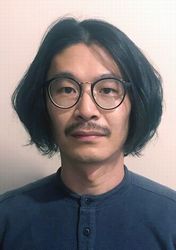Interview with Liberal Arts Communicator SAWAZAKI Kenichi
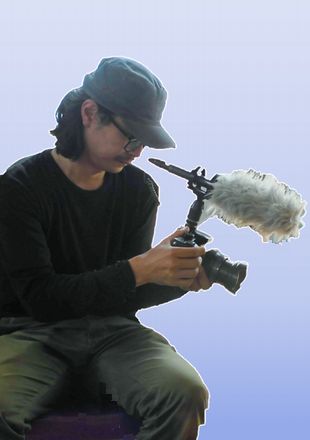
Interview with Liberal Arts Communicator SAWAZAKI Kenichi
(Research Institute for Humanity and Nature)
What inspired you to pursue the field of cinematography?
When I was a child, we frequently moved and lived in various parts of the country because of my father’s job. Perhaps as a result, I had a sense of always being an outsider among the people of each community we lived in and my sense of involvement with my peers did not develop. So I was often swept by mixed feelings: I was like a wanderer without roots who does not belong anywhere, and yet, wherever I was, I thought there was a place for me.
Things went on like this for a while. But then, while at university, I became fascinated with film and contemporary art and worked on location in film production. Around the same period, I acquired an eight-millimeter movie camera for the first time. I later upgraded to high-band Video8 (Hi8) and digital video (DV) formats, and began filming various events.
Then, strangely enough, I began to feel as if my camera was connecting me with the outside world from which I used to feel detached. Having a camera gave me some sense of validation for being wherever I was. It took me a while, though, to identify this sensation.
Around 2007, I entered the International Academy of Media Arts and Sciences (IAMAS)—which later closed down in 2012]—and began to create and present contemporary art using film. This was how I started to pursue the field of cinematography.
What is the appeal of capturing the present moment on camera, and examining world events and human affairs through film?
The attraction of film can be discussed from several angles. The first is its interesting capability to mediate between “them” and “us”. In other words, through moving images, film can connect people in Africa (“them”) and those living in Japan (“us”). In my case, I also use film media as an intermediary between different disciplines, cultures, religions, and other factors. Film can foster unexpected connections between these vastly different elements, and I would describe this as one of the special qualities of this medium.
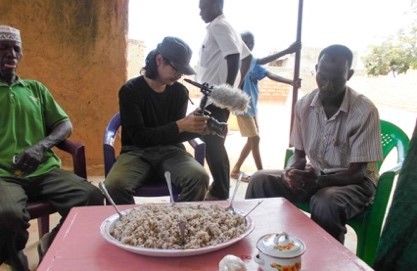
Sawazaki shooting footage in Burkina Faso, 2016. (Photo by Shimizu Takao)
The second point is its suitability for recording people’s intuitive sensibilities. Having documented footage of various people in Africa, Southeast Asia, Europe, and elsewhere, I have come to believe that no other medium can better depict the personality of the subject, the atmosphere of the location, the nuanced rhythms and metamessages in people’s conversations, or the relationships between different things. The appeal of filming events and human activities around the world is that through such work we can allow all kinds of people to share such sensibilities, create opportunities for learning, and bring people together for connection.
The third point is the distinct way that film captures time. Despite documenting the “now” while recording, the footage instantly turns into an archive of the past. Yet, these records can often evoke vibrant joy and interest among those in the present. Furthermore, these types of footage—once a record of the “present”, now a snapshot of the past—have high reproducibility and can spread infinitely, much like a cellular division process. Time in our world seems to progress in an irreversible and linear manner, but from a film-centric viewpoint, reality can be seen as an amalgam of reversible, non-linear, and extremely complex networks.
By creating footage of various researchers’ activities, what insights have you gained, and what unexpected events have you witnessed?
In 2016, I directed The Garden in Movement, a theatrically released 85-minute documentary that chronicles the endeavors of French gardener Gilles Clément. What inspired the production of the film was a project I undertook with the Research Institute for Humanity and Nature (RIHN), with which I am currently affiliated. In 2015, RIHN hosted Clément’s lecture series in Japan, and I was asked to document the landscape designer’s tour around the country—this was his first visit to Japan—as well as his speaking engagements. The footage is publicly available on RIHN’s YouTube channel under the title Gilles Clément, un Jardinier Français au Japon (Sawazaki 2015).
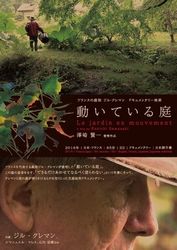
Poster of the documentary film The Garden in Movement.
Six months after Clément’s trip to Japan, I went to visit him in France on my own. I filmed his garden there—areas referred to as the “La Vallée” and “Le Champ”—which inspired his “The Garden in Movement” philosophy: a concept that encourages one to embrace and not alter the dynamics of nature. I then edited the footage, and this came out as my 2016 documentary film. The work, produced in line with Clément’s motto as a gardener (i.e., “To do as much as possible with, as little as possible against”), is ethnographic footage that uses long shots to document Clément’s tour around Japan and his home garden.
After producing the film, I became involved in various RIHN projects. Particularly notable was my acquaintance with agronomist Tanaka Ueru, the leader of the “Desertification and Livelihood in Semi-Arid Afro-Eurasia” project that ran through the academic years 2012 to 2016, and cultural anthropologist Shimizu Takao, a researcher who participated in the project. While accompanying their field research and that of many other scholars, I amassed hours of footage. I also launched my personal research around this time with funding from the Toyota Foundation, focusing on the sensibilities of on-site field research*1.
Through documenting various field researchers’ study sites, I realized that the act of filming significantly influences the on-site behavior of both the cameraperson and the subject. My basic shooting approach had been to follow the lead of the subject and minimize any disruption to the subject’s actions, but the scholars reacted differently when subjected to the gaze of the camera, which in turn triggered varied responses from me as well. This dynamic felt like an improvised dance between me—the cinematographer—and the person being filmed. Interactions and decisions in the field are spontaneous and often surprising even for the persons involved, and accordingly play a key role in the research process. Subjecting researchers to the camera alters their on-site mindset to some extent, which is why footage that documents the atmosphere of the research site is deeply insightful for both scientific research and artistic practice alike. In my doctoral program at Kyoto City University of Arts, completed in 2021, I discussed, through research and creative processes, methods to express such sensitivities in visual form within field investigations*2.
---
*1 The Toyota Foundation, 2016 Research Grant Program, D16-R-0344, Senses of Field Studies Standing on Peoples' Livelihood: The search for phenotype of interdisciplinary research to take advantage of the video media.
*2 Kenichi Sawazaki, Living Montage : The Margins of the Field Research and the method born from the "Eyes of the In-Between", Kyoto City University of Arts, 2016
Please tell us what inspired you to become a liberal arts communicator.
Becoming a liberal arts communicator was not my initial plan, but my collaborations with RIHN sparked the idea. Having worked with various researchers through RIHN as an outsider, I came to think that by engaging in RIHN’s projects as a member of the institute and from a fresh perspective, I could open up possibilities for new endeavors; ones that leverage my previous film media-based pursuits. With that potential in mind, I decided to apply for the position.
In fact, I was entirely unaware of the post until I saw the job description. Upon reflection, while preparing for my application, I concluded that the liberal arts is about connecting society with the vanguard of academic research, working with diverse people to explore how one should navigate life in this world, and putting ideas into practice. I was attracted to liberal arts communicators because they strive to engage with society strictly from a researcher’s standpoint.
Instead of following the typical career trajectory of a scholar, I have thus far pursued my own path as an artist and film director. But I decided to apply for the post because my work has undeniably revolved around the liberal arts, and I thought I could contribute to the field in some way. I was also motivated by the prospect of becoming a good role model as a liberal arts communicator in the mid- to long-term, creating a career path for research-based artists and filmmakers to thrive as scholars.
What activities do you undertake at RIHN?
Gilles Clément has been chosen as the fourteenth inductee of “The Earth Hall of Fame Kyoto” an award to honor those who have significantly contributed to global environment conservation. As an event related to this prize and as one of RIHN’s social co-creation communication projects, I have hosted “The Garden/Dialogue in Movement” on November 5, 2023 with my colleagues.
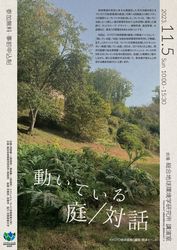
Poster of the event “The Garden/Dialogue in Movement”.
For this event, I have screened the documentary film The Garden in Movement. I also intended to use a new experimental method and set an opportunity for dialogue with the participants, while sharing footage of Emmanuel Marès—who appears in the film—and myself visiting Clément’s home garden for the first time in about eight years. The method is guided by the keywords “philosophical dialogue”*3 and “Meta Films”*4. The former involves exploring and discussing philosophical themes with event attendees, while the latter is a filmmaking style that incorporates viewer feedback into the film content.
To be more specific, participants have watched the footage of Clément and shared any thoughts that came to mind. The dialogue session was filmed, and from the recorded material, noteworthy comments will be selected and added as voice-overs to the original footage screened at the event. Following a re-editing process, I plan to present the finalized Meta Films work again at a screening or other events.
The drive behind this endeavor is my aspiration to create an opportunity for people to not just learn about Clément, but to be inspired by him and to communicate and spread that inspiration. Like plants, humans are ever-changing and never static. I am committed to capturing the vibrant yet subtle transformations in people and sparking a more dynamic movement. In tribute to Clément’s “The Garden in Movement” philosophy, I would like to call this series of efforts “The Dialogue in Movement”.
---
*3 In his book Kangaeru towa dōiu koto ka [What Does It Mean to Think?] (Tokyo: Gentōsha Shinsho, 2018), philosopher Kajitani Shinji of the University of Tokyo sets forth eight rules for philosophical dialogue.
https://www.u-tokyo.ac.jp/focus/en/features/diversityresearch05.html
*4 Sawazaki, an artist and film director, has been utilizing this film production method in recent years, focusing on the creativity derived from the act of film-viewing. Some of his work that uses this method include #manazashi (Sawazaki 2021) and #manazashi Young Muslim’s Eyes (Sawazaki 2023).
How do you want to approach the role of a liberal arts communicator from here on?
Currently, I am hoping to plan an event to share two major cases and discuss how cinematography can be applied to academic research.
The first example is a screening event and a study session to explore the ways in which cinematography can be utilized in field research. This will include reflections on the interdisciplinary platform “Living Montage” which I launched with researchers and designers as a product of my Toyota Foundation-funded research, and also on the multilayered documentary film #manazashi (Sawazaki 2021), produced by documenting the fieldwork of Shimizu Takao and Tanaka Ueru.
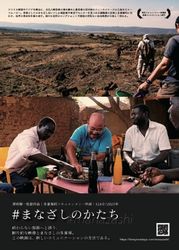
Flyer of the film #manazashi.
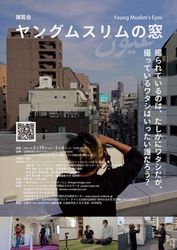
Flyer of the Young Muslim’s Eyes exhibition.
The second example is another screening event and study session to discuss the potential applications of participatory research. This undertaking introduces the efforts related to the joint research project “Young Muslim’s Eyes: Crosswork between Arts and Studies”—the subject matter of which is young Muslims who grew up within the Japanese cultural sphere—while focusing on the “Commons Films”*5 approach that characterizes the project.
---
*5 This is a filmmaking method Sawazaki has been proposing in recent years. Basically, it involves all participants shooting each other with cameras and sharing the footage on a cloud service as a shared resource pool (i.e., a data commons). Each person then uses the shared materials for their own film production process, guided by their individual values and ideas. This process fosters a performative relationship that transcends the “subject-and-object” framework (e.g., the researcher versus the filmed subject). The method accordingly promotes co-creation efforts that are not predicated on such factors as positions, generations, cultural and religious backgrounds, or the fields of specialty as to the researcher, the person subjected to research, and stakeholders.
(Interviewer: OHBA Go, Researcher, Center for Innovative Research, National Institutes for the Humanities)
SAWAZAKI Kenichi
Specially Appointed Assistant Professor, Research Institute for Humanity and Nature
Sawazaki is an artist, film director, curator and researcher who earned his PhD in Fine Arts from the Faculty of Fine Arts, Kyoto City University of Arts.
He is the representative director of Living Montage, an interdisciplinary platform that utilizes film media. Based on a contemporary art perspective with a particular focus on film, he actively collaborates on projects with people from different fields and cultures to create new artistic and cultural paradigms. He manages and plans undertakings for “Living Montage”, the joint project “Young Muslim’s Eyes: Crosswork between Arts and Studies” and the interdisciplinary project “Sensory Dialogue: Creating Sites for the Co-creation of Art and Science”. His recent works include the exhibition “Young Muslim’s Eyes: The One Being Taken a Picture of Is Certainly Me, but I Wonder Who Is the One Taking the Picture?”—hosted at Kyoto Seika University’s satellite space Demachi in 2023—as well as the multilayered documentary film #manazashi (Sawazaki 2021), which won many domestic and international awards, and the theatrically-released film The Garden in Movement (Sawazaki 2016), premiered at the eighth Yebisu International Festival for Art & Alternative Visions.
